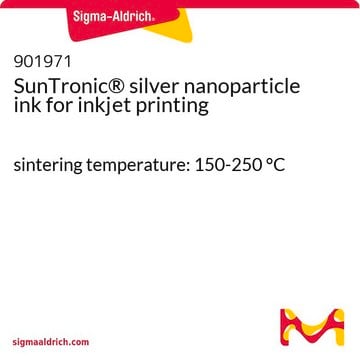736511
Silver, dispersion
nanoparticle, 40-50 wt. %, spec. resistivity < 0.001 Ω-cm, for printing on ITO and glass
동의어(들):
Silverjet DGH-55HTG, silver ink
About This Item
추천 제품
설명
surface tension 40 - 70 mN m-1
형태
dispersion
nanoparticle
농도
40-50 wt. %
refractive index
n20/D 1.333
입자 크기
≤10 nm
점도
900-1600 mPa.s ((25°C))
density
1.5-1.8 g/mL at 25 °C
저장 온도
20-25°C
SMILES string
[Ag]
InChI
1S/Ag
InChI key
BQCADISMDOOEFD-UHFFFAOYSA-N
유사한 제품을 찾으십니까? 방문 제품 비교 안내
일반 설명
면책조항
신호어
Danger
유해 및 위험 성명서
Hazard Classifications
Acute Tox. 4 Oral - Aquatic Acute 1 - Aquatic Chronic 1 - Eye Dam. 1 - Skin Corr. 1B - STOT SE 2
표적 기관
Eyes,Central nervous system
Storage Class Code
8A - Combustible corrosive hazardous materials
WGK
WGK 3
Flash Point (°F)
217.9 °F
Flash Point (°C)
103.3 °C
시험 성적서(COA)
제품의 로트/배치 번호를 입력하여 시험 성적서(COA)을 검색하십시오. 로트 및 배치 번호는 제품 라벨에 있는 ‘로트’ 또는 ‘배치’라는 용어 뒤에서 찾을 수 있습니다.
문서
Inkjet printing is one of the key enabling technologies of printed electronics. Inkjet printing technology classification, aspects of materials (inks, substrates) and respective pre-and post-processing steps are discussed.
Functional materials for printed electronics applications enable flexible displays, RFID tags, and biomedical sensors.
The ability to pattern conductive electrodes is technologically relevant for several applications, including photovolatics, displays, sensors, and biomedical devices.
Progress in solution-processed functional materials leads to thin-film optoelectronic devices for industrial and consumer electronics.
자사의 과학자팀은 생명 과학, 재료 과학, 화학 합성, 크로마토그래피, 분석 및 기타 많은 영역을 포함한 모든 과학 분야에 경험이 있습니다..
고객지원팀으로 연락바랍니다.











